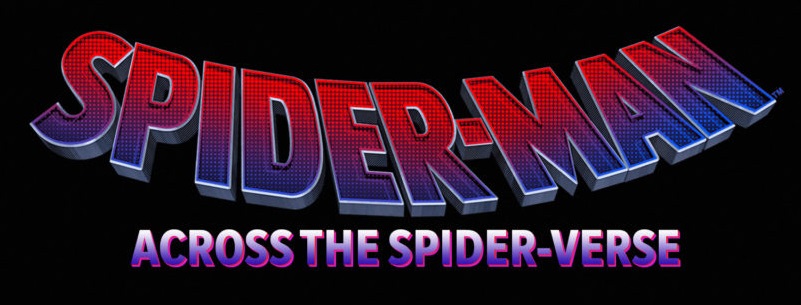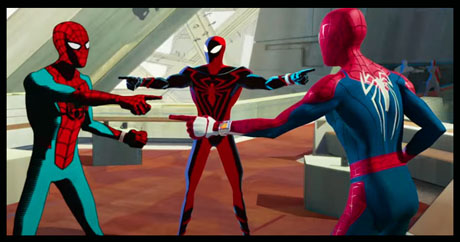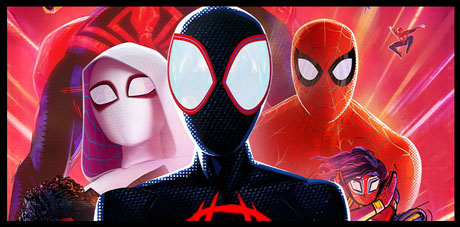
It is best, perhaps, to consider Spider-Man: Across the Spider-Verse (Henceforth, ATSV) in its correct context for the purpose of this review. The film is not a sequel to Into the Spider-Verse, but a carefully planned second part of a trilogy scheduled to conclude in March 2024. This escaped the notice of some irate moviegoers (including several at the screening I attended who protested the film’s ending in unhappy amazement). I bring this point up because I want to dive deeper into what I believe this picture’s true intent may have been.

All right, first of all, ATSV is a stunning extravaganza of technical virtuosity. Every production style of animation extant is showcased, typically at a speed that nearly defies visual processing. Some characters, such as Spider-Punk and the alternate universe Vulture, are colored and animated differently than any other character, and each alternate universe, of which there are many, has its own palette.
Some of the setpieces are astounding: the team-up between Miles Morales, Spider-Gwen, Jessica Drew (Spider-Woman), and Miguel O’Hara (Spider-Man 2099), as they battle the Vulture, as mentioned above, in the Guggenheim Museum, is among the best fight scenes ever animated. The Vulture is animated in the sepia tones of Leonardo da Vinci’s famed notebooks and fights as if he were a 15th Century mechanoid. When Spider-Man takes on the Spot, one of the film’s primary villains, the combatants tumble through dimensional ink-blots and disappear, only to re-emerge unpredictably, at top speed, in any corner of the frame, fighting and contorting as they do so.
There is enough breathing space for the viewer to follow the plot, which has several twists, including a non-contrived shocker at the end that redefines the meaning of “cliffhanger.” Since I do not release spoilers, suffice it to say that the story (written by Phil Lord, Christopher Miller, and David Callaham) is a beautiful frame to which the incredible animation is married. The direction by Joachim Dos Santos, Kemp Powers, and Justin K. Thompson (all of whom worked on the first Spider-Verse movie) keeps the visual chaos from taking complete control of ATSV. Whether the action occurs in Mumbattan, India, Spider Central, where over two hundred Spider-Beings reside, or a hilarious cutaway to a stop-motion Lego universe, the cohesion is never lost.

The acting is just as complimentary: Shameik Moore and Hailee Steinfeld reprise their roles as Spider-Man and Spider-Gwen, as does Jake Johnson, portraying Peter Parker, the Spider-Man of “our” Earth. Special kudos to James Schwartzman as the (initially) wimpy Spot and a tremendous emotional performance by Shea Whigham as Gwen’s conflicted father. There are many more, including Karan Soni as Spider-Man India and Luna Lauren Velez as Miles’ compassionate mother.
Back to my original premise: The two existing Spider-Verse movies are perhaps the most brilliant continuations of a trilogy since the first two Godfather or Star Wars films, and this brings us to my observation: Both the movies mentioned above are encapsulations of cinematic traditions, the Gangster film and the swashbuckling science-fiction serial. The tropes found in both genres are echoed in both episodes and have been refined to the point where they seem almost unique rather than. The Spider-Verse movies perform the same function but for a different medium.
The Spider-Verse films summarize the entire history of the Spider-Man saga that spans the gamut from Amazing Fantasy #15 to the multiplicity of Spider-Man comics available today. In doing so, every era and incarnation of Spider-Man (yes, even including the lamentable Ben Reilly) is represented, most often in Easter Egg form or in an alternate format. In effect, Spider-Man, as a creative concept, IS the Spider-Verse, an iconic figure malleable by countless imaginations. ATSV is cemented together by mythological “canons,” which cannot be violated, but the character himself can have boundless forms and histories within that framework.

One canon, not mentioned in the film but certainly part of the comic book legend is a five-word phrase. Those disappointed at the movie’s end were unaware of this canon:
“To be continued next issue!”
I am now 67 years old. I have been reading Marvel Comics since the 1960s, during the heyday of Lee, Kirby, Ditko, et al. I can recall one afternoon, after purchasing The Amazing Spider-Man #199 and the thrill of reading it to the last panel where we were led to believe Mysterio killed Spider-Man by shooting with a dart containing enough poison to kill a hundred elephants. The proclamation below the body of Spider-Man as he lay motionless on the floor: “Next Issue: Spider-Man #200!” How could I wait a month for that! And that is what our lamenting moviegoers did not appreciate: The Canon. ATSV gave me the same thrill, and I cannot wait to feel it again.
- ANIME REVIEW: “Lonely Castle in the Mirror” - September 24, 2023
- REVIEW: “Teenage Mutant Ninja Turtles: Mutant Mayhem - August 15, 2023
- REVIEW: “Spider-Man: Across The Spider-Verse” - June 7, 2023


 June 7th, 2023
June 7th, 2023  Martin Goodman
Martin Goodman  Posted in
Posted in  Tags:
Tags: 






